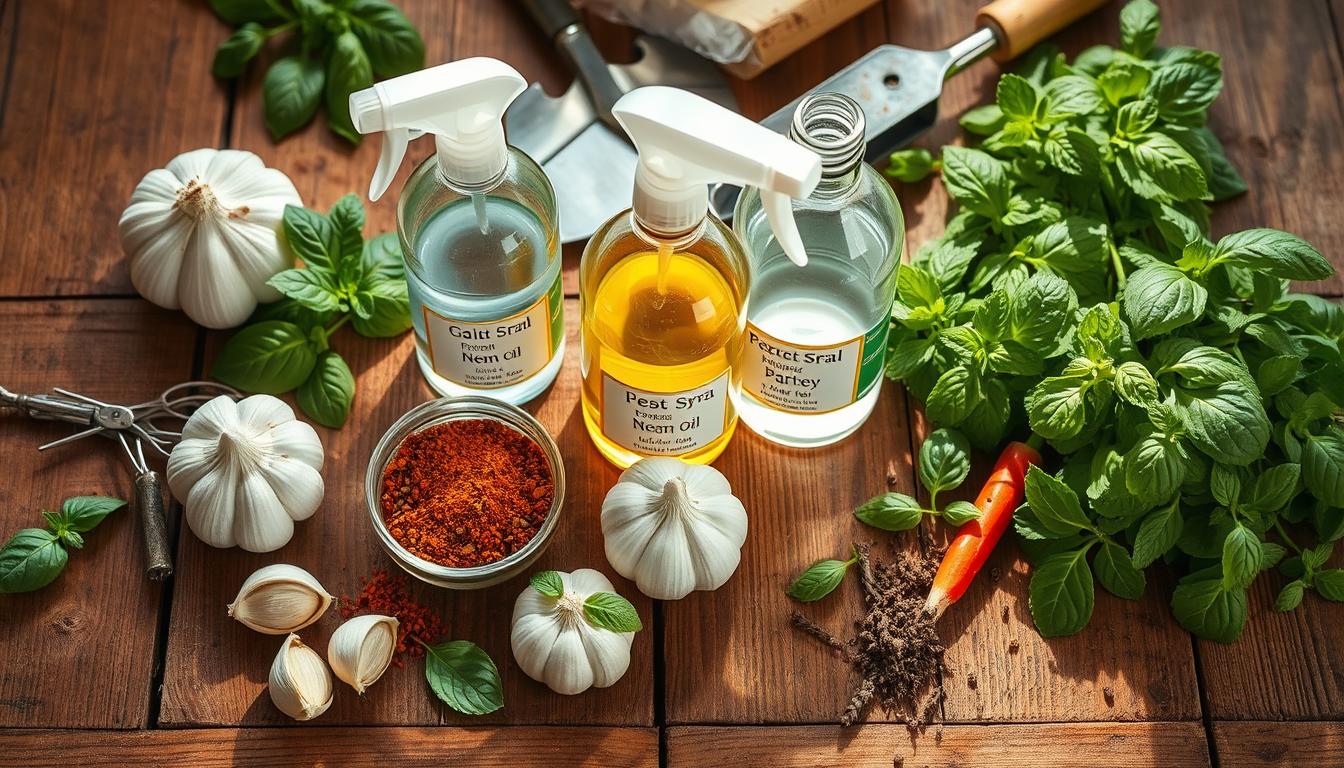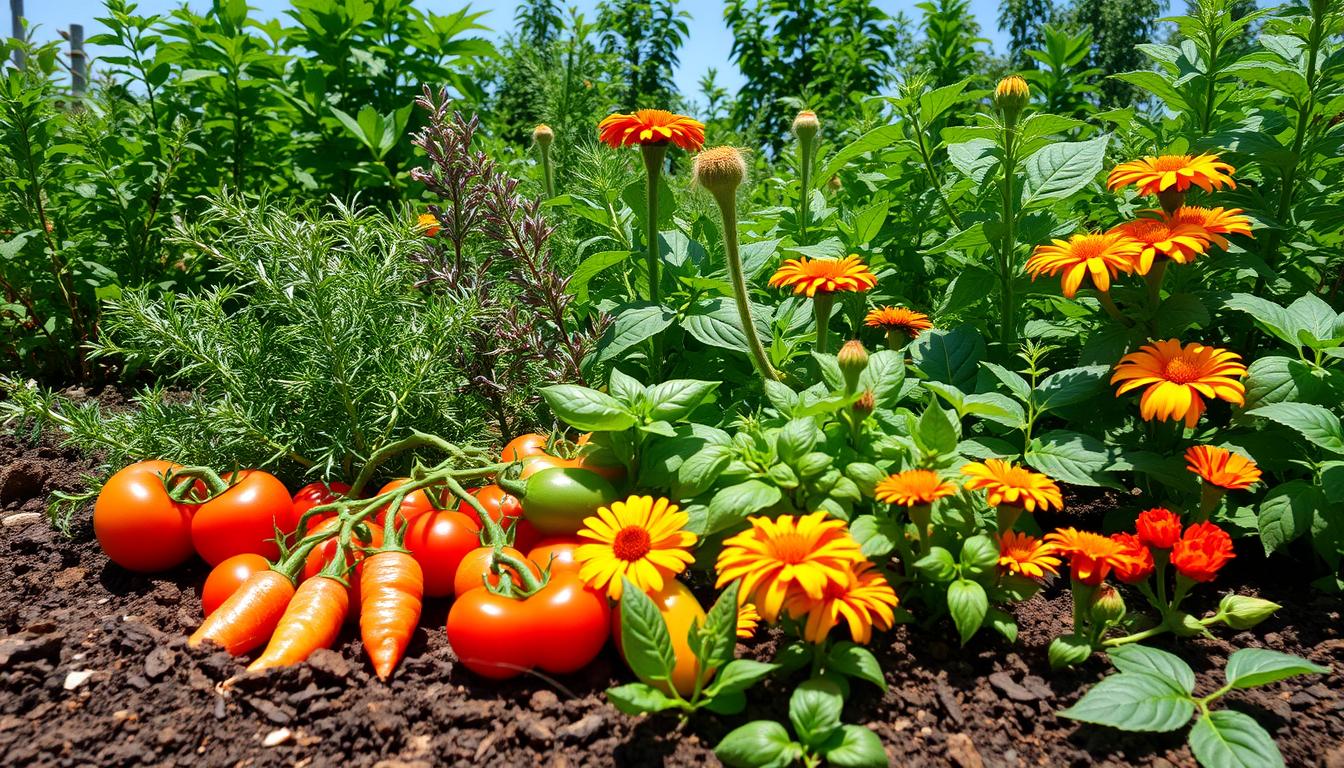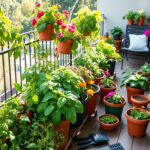Did you know 90% of people have pesticide byproducts in their urine? This fact highlights the importance of organic garden pest control for both our health and the planet.
I’ve found that using natural pest control in gardens is essential. It’s not just a trend. It keeps our gardens healthy and safe for wildlife.
Learning about organic pest management has been eye-opening. It takes up to three years to get a garden’s soil right, but it’s worth it. By using natural methods, gardeners can keep their crops safe and maintain a balanced garden.
More than 80% of homes in the U.S. have a garden or backyard. So, learning organic pest control is key for gardeners. In this guide, I’ll share easy ways to protect your crops without using harmful chemicals.
Choosing organic pest control helps your plants and the planet. Let’s dive into the world of natural pest management together!
Understanding Organic Pest Control Methods
Protecting your garden needs a careful plan for pest management. Non-toxic pest control is more than just getting rid of bugs. It’s about making your garden a balanced place that fights off pests naturally. I’ve learned that working with nature is more powerful than fighting it.
What is Organic Pest Control?
Organic pest control is a complete plan that uses natural ways to prevent pests.
It follows a method called Integrated Pest Management (IPM) with six key steps:
- Correct pest identification.
- Continuous monitoring.
- Establishing acceptable damage thresholds.
- Evaluating results.
- Implementing natural control methods.
- Maintaining ecosystem balance.
Benefits of Organic Methods
Organic methods have many benefits. Cultural control methods are the most effective for stopping plant diseases. By keeping plants healthy and the ecosystem in balance, you make it hard for pests to thrive.
Healthy plants are your first line of defense against garden pests.
Comparing Organic and Conventional Approaches
By choosing non-toxic pest control, gardeners can build strong, pest-resistant gardens. These gardens not only fight pests but also help the environment.
Organic approach and conventional method chart:
| Organic Approach | Conventional Method |
| Focuses on prevention | Relies on chemical interventions. |
| Supports ecosystem health | May harm beneficial insects. |
| Long-term sustainable solution | Short-term pest elimination. |
| Environmentally friendly | Potential environmental risks. |
Common Garden Pests and Their Effects
Keeping your garden safe from pests is key to growing healthy crops. Knowing which insects and animals harm your plants helps you use the right organic solutions.
Garden pests can quickly ruin your crops. About 15 common pests are major threats to vegetables.
Identifying Common Garden Pests
Some big pests include:
- Aphids: Tiny insects that cluster on plant leaves.
- Cucumber Beetles: Transmit bacterial diseases.
- Cabbage Worms: Can destroy leaves completely.
- Colorado Potato Beetles: Damage plant leaves.
How Pests Damage Your Crops?
Each pest damages plants in its own way. Beetles and caterpillars chew holes. Sucking pests turn leaves yellow and dead.
Pest, Target crops and damage type chart:
| Pest | Target Crops | Damage Type |
| Aphids | Tomatoes, Lettuce, Kale | Deformed Growth. |
| Cabbage Worms | Cabbage Family | Complete Defoliation. |
| Cucumber Beetles | Cucurbits | Leaf Damage and Disease Transmission. |
An expert says,
Early detection and prevention are key to protecting your garden from devastating pest infestations.
Using organic pest control can greatly reduce damage and keep your garden healthy.
Natural Predators: Nature’s Pest Control
Garden ecosystems thrive with the help of natural predators. These tiny warriors can change how we control pests. They offer homemade remedies that work with nature’s balance.
Beneficial Garden Insects
My garden is a home for beneficial insects that control pests. The lacewing is a great example. It can eat up to 200 aphids in just one week. By creating the right habitat, you can invite these natural pest controllers to your garden.
Beneficial Insects to Attract
- Ladybugs: Consume up to 50 aphids daily.
- Hoverflies: Devour around 60 aphids per day.
- Lacewings: Eat up to 200 aphids weekly.
Creating a Predator-Friendly Habitat
To design a habitat for natural predators, you need a plan. Diverse gardens with many plant species prevent pest outbreaks. By adding different flowering plants, you support beneficial insects and cut down on chemical use.
Predator, daily pest consumption and habitat preferences chart:
| Predator | Daily Pest Consumption | Habitat Preferences |
| Ladybugs | 50 Aphids | Flowering plants, herb gardens. |
| Hoverflies | 60 Aphids | Diverse flowering species. |
| Lacewings | 200 Aphids/Week | Native perennials. |
An expert says,
By supporting natural predators, we can reduce chemical pesticide use by up to 50%.
To make your garden welcoming, provide resources all season. Plant native flowers, offer water, and avoid harsh chemicals. Your garden can become a thriving ecosystem where beneficial insects manage pests naturally.
Homemade Organic Pest Control Solutions
Making your own organic pest repellents is a great way to keep your garden safe. It’s easy and effective when you know how. Natural pest control for gardens can be simple yet powerful.
Homemade Organic Pest Spray Ingredients
I’ve come up with some reliable homemade pest control recipes. They are safe and work well. Here are some of my top picks to keep pests away from your plants.
Powerful Organic Pest Control Recipes
- Garlic Spray: Mix 1 head of garlic with 2 cups of water and 1 tablespoon of non-bleach dish soap.
- Baking Soda Solution: Combine 2 tablespoons of baking soda with 2 quarts of water.
- Hot Pepper Repellent: Blend 1/2 cup of chopped hot peppers with 2 cups of water.
Application Tips for Organic Pest Control
Here are some important tips for using these natural pest control solutions:
- Always test the spray on a small plant section first.
- Apply sprays in the evening to prevent leaf burn.
- Spray 1-2 times per week or after heavy rain.
The Role of Sticky Traps
Sticky traps are also great for organic pest control. They catch flying insects and show you how many pests are in your garden. Organic gardening wisdom,
Natural pest control is about working with nature, not against it.
Pest control method, effectiveness and ease of use chart:
| Pest Control Method | Effectiveness | Ease Of Use |
| Garlic Spray | High | Easy. |
| Baking Soda Solution | Medium | Very Easy. |
| Hot Pepper Repellent | High | Moderate. |
| Sticky Traps | Medium | Very Easy. |
Using these organic pest repellents will make your garden healthier. It will naturally keep pests under control.
Essential Oils in Pest Management
Organic garden pest control has found a strong ally in essential oils. These natural extracts are a safe and effective way to keep pests away from your plants. Nature has given us amazing tools to fight garden pests.
Essential Oils For Garden Pest Control
Essential oils mess with pests’ senses, making them a great tool for gardeners. Peppermint essential oil is a top choice for keeping many insects away. More gardeners are turning to natural pest control methods.
Best Essential Oils for Deterring Pests
- Peppermint: Repels multiple insect species.
- Neem: Effective against aphids with a 70% success rate.
- Clove: Powerful antifungal agent reducing fungal growth by 80%.
- Lavender: Deters pests and attracts beneficial pollinators.
- Rosemary And Thyme: Increase plant resilience by 15%.
How to Use Essential Oils Safely
It’s important to use essential oils correctly for organic pest control. Placing essential oil-infused cotton balls in strategic spots can cut pest activity by almost half. Pro tip: Spray essential oil solutions every two weeks to keep pests away all season.
By mixing different essential oils, you can boost their pest-repelling power by about 25%.
Using essential oils in organic gardens can cut down on chemical risks by up to 90% compared to synthetic pesticides. This method not only protects your crops but also helps the environment.
Companion Planting to Ward Off Pests
Gardening is more than growing plants. It’s about building a community where plants help each other. Companion planting uses natural plant relationships to keep pests away.
Companion Planting Garden Layout
I started companion planting to cut down on chemicals. I found that placing plants wisely can make my garden healthier and pest-free.
Understanding Companion Planting Basics
Companion planting means growing certain plants together to keep pests away. Some plants send out chemicals that scare off bugs. Others attract good bugs that eat pests.
Top Companion Plants for Pest Management
- Marigolds: Repel deer, rabbits, and many insects.
- Thyme: Keeps cabbage worms and other pests away.
- Nasturtiums: Lure aphids away from important plants.
- Borage: Draws in pollinators and keeps tomato hornworms off.
Using these plants can make your garden stronger and more balanced.
Designing Your Companion Planting Strategy
Choose plants that fight your specific pests. Diversity is key for a strong defense. Add flowers like sweet alyssum and zinnias to attract good bugs. Ecological gardening principle,
In nature, nothing exists alone.
Companion planting is a way to work with nature, not against it.
Organic Garden Maintenance Practices
Keeping your garden healthy is key to non-toxic pest management. From my gardening years, I’ve learned that stopping pests before they start is best. This approach is safer for the environment.
Good garden care means using several important strategies. Crop rotation is a big help in keeping your garden safe from pests. By switching up what you grow each year, you can fight off soil diseases and pests.
Essential Garden Maintenance Techniques
- Monitor soil nutrient levels regularly.
- Practice strategic crop rotation.
- Maintain garden cleanliness.
- Promote biodiversity.
Keeping Your Garden Clean and Healthy
A clean garden is your first defense against pests. Get rid of dead plants, leaves, and debris that pests and diseases like. Healthy soil means stronger plants that can fight off pests on their own.
Maintenance practice and pest prevention impact chart:
| Maintenance Practice | Pest Prevention Impact |
| Crop Rotation | Reduces soil-based pest populations. |
| Garden Cleanliness | Eliminates pest breeding grounds. |
| Diverse Planting | Creates natural pest resistance. |
Using these methods, you’ll build a strong garden that fights pests naturally. Remember, a healthy garden is your best pest control strategy.
Nature provides the most effective pest control when we work with its principles.
Using Diatomaceous Earth and Other Natural Ingredients
Gardeners looking for organic pest repellents have found a great ally in natural ingredients. These homemade remedies are safe and good for the environment. They help keep your plants safe from pests.
The Power of Diatomaceous Earth
Diatomaceous earth is a natural pest control that works in a unique way. Its tiny silica particles are very effective against hard-shelled insects. It damages the insects’ exoskeletons, causing them to dehydrate by removing their wax coating.
- Kills crawling insects like ants and cockroaches.
- Effective against spiders, silverfish, and bedbugs.
- Safe for use up to harvest day.
Application Tips for Maximum Effectiveness
Here are some tips for using diatomaceous earth effectively:
- Use only Food Grade Diatomaceous Earth.
- Create a 2-inch barrier around garden foundations.
- Apply on wet plants for better adherence.
Other Natural Pest Control Products
Natural product, pest targets and application method chart:
| Natural Product | Pest Targets | Application Method |
| Neem Oil | Aphids, Whiteflies | Spray on affected plants. |
| Pyrethrin | Flying Insects | Direct contact spray. |
An expert says,
Remember, organic pest control is about working with nature, not against it.
By using these natural organic pest repellents, you’ll make your garden healthier. This protects your plants without using harsh chemicals.
Resources for Further Learning
My journey in organic garden pest control has shown me the importance of learning every day. The world of natural pest control is always changing, so gardeners must stay up-to-date. There are many resources to help you learn more about managing pests without using harmful chemicals.
Books are a great source of knowledge for organic gardeners. Look for books by experts like Dr. Jeff Gillman and Mark Highland. They share a lot about sustainable gardening. Online communities are also very helpful. Gardeners there share their experiences and tips for controlling pests organically.
Local agricultural extension offices are often overlooked but are very helpful. They offer workshops, specific advice for your area, and connect you with other gardeners. Joining local gardening groups or attending seminars on sustainable pest management can also be beneficial.
Recommended Online Learning Platforms
Digital platforms like Coursera and Udemy have great courses on organic gardening and pest control. These courses can help you learn advanced skills in natural pest control. Remember, learning is a journey, and each season brings new challenges and chances to improve your gardening skills.
Frequently Ask Questions (FAQ)
What exactly is organic pest control?
Organic pest control uses natural, non-toxic ways to manage pests. It keeps your plants safe without harmful chemicals. You can use beneficial insects, homemade sprays, and natural predators to protect your garden.
Are homemade pest control solutions really effective?
Yes, they are! Homemade solutions like garlic and pepper sprays can keep pests away. Neem oil is also a strong natural insecticide. These methods are good for the environment and your plants.
How do I attract beneficial insects to my garden?
Plant a variety of flowers like marigolds and lavender to attract beneficial insects. Create water sources and avoid chemical pesticides. Herbs like dill and fennel also attract predators that fight pests.
Can companion planting really help control pests?
Yes, it can. For example, basil near tomatoes repels pests. Marigolds deter nematodes. Some plants repel pests or attract beneficial insects, making your garden healthier.
Is diatomaceous earth safe to use in my garden?
Diatomaceous earth is safe and effective against soft-bodied insects. It’s non-toxic but should be used carefully. It damages insects’ exoskeletons, making it a great organic solution.
How often should I apply organic pest control methods?
The frequency depends on your pest issues and methods. Homemade sprays should be applied every 7-10 days. Companion planting is ongoing. Always watch your garden and adjust your methods as needed.
What are the most common garden pests I should watch out for?
Watch for aphids, spider mites, caterpillars, slugs, and whiteflies. Each pest needs a different approach. Early detection helps manage pests with organic methods.
Can essential oils really help with pest control?
Yes, they can. Peppermint, lavender, and tea tree oils are effective. But, use them sparingly and dilute them correctly. Always test a small area first.




















